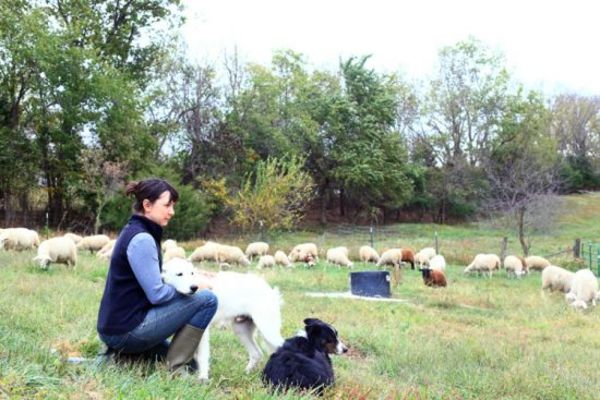Jacqueline Smith on Her Rad Sustainable Farm, Green Dirt

When Jacqueline Smith, co-owner and farmer at Green Dirt Farm, was a teenager, she vowed to stop eating meat. Smith’s culinary change of heart wasn’t rooted in cliché teen angst, though. She ceased eating meat to boycott the industrial farm system. While Smith’s passion for sustainable farming remains strong, she dropped her personal boycott long ago. Smith now co-owns and operates Green Dirt Farm, a community-based farm specializing in sheep’s milk cheeses and 100 percent grass-fed lamb in Weston, MO. We recently interviewed Smith and asked her why she became a farmer, why she strives to keep her farm’s product standards high and practices sustainable, and what she has planned for Green Dirt in the near future.
Abbie Stutzer: Did you decide to become a farmer because you grew up on a farm?
Jacqueline Smith: I did not grow up on a farm. However, growing up, my family spent much of our time together in the outdoors: camping, fishing or horseback riding. I think this foundation helped mold my appreciation for nature and the environment. As I grew up I became increasingly aware of how our food is produced. As a teenager, I felt so helpless against the huge industrial farming industry that I boycotted eating meat and tried to not use products that came from this industry. It didn’t dawn on me as a teenager that I could use this passion for change instead of boycotting animal products all together.
Another reason I was interested in farming was the simple fact that I found the lifestyle of farming very enchanting. I knew that one day I wanted to be a mother and wanted to raise my children in an environment that allowed me to be present. I saw farming as an opportunity to be a mother and have a career. It wasn’t until I was in college that I began entertaining ideas of choosing farming as a career. Of course I had no idea how to do this since I didn’t have any role models at the time in farming, nor had I ever spent much time on a farm let alone working on one. But my passion for ethical eating set me in the direction of learning how I might become a farmer. I began researching small-scale agriculture, apprenticing on small vegetable farms and took a few agricultural business classes. At that time I was focused on vegetable production.

AS: How did you meet Sarah Hoffmann (co-owner and cheesemaker at Green Dirt)?
JS: I met Sarah while I was still in college. She had already begun to research farming opportunities and had purchased about 25 acres in Weston, where we currently operate our farm.
AS: Why did you two decide to farm together?
JS: When Sarah and I became friends, we quickly became aware that we shared a lot of the same goals and interests for ourselves, our families and our community. We began working on farm business plans. Since Sarah already had land, we decided to farm on her land. After doing some soil testing it became obvious that the land was not suitable for vegetable farming. The soil is very fine and erosion happens very quickly in our soils. Plus the terrain is rolling with steep inclines and deep valleys. The land had been farmed for tobacco, corn and soy previous to Sarah purchasing the land so most of it had lost much of its nutritional value. But we realized that to create a sustainable farm, we needed to farm the land for what the land is best suited for. Plus after developing the business plan, we realized that if we were going to farm as our primary source of income, we needed to create a business structure that added value back to the raw product we produced. This led us to researching building a dairy. Because of the soil and rolling hills, dairy cows would cause more erosion. Also, goats had already saturated the dairy market, so that left us with sheep. We became members of the Dairy Sheep Association of North America and went to our first DSANA conference where we learned about the wonderful qualities of sheep milk and sheep milk cheeses. It has proven to be a great market for us since it is still a very young market in the U.S. and there is a lot of opportunity to expand the market.
AS: How long did it take to install the renewable energy sources used on the farm?
JS: All of our business planning involved using renewable energy sources on the farm. We accounted for the extra expense when searching for financing. Most of the renewable energy sources were installed when we were in building the infrastructure of our farm. Of course, we are constantly trying to improve our energy sources and adding additional renewable sources as we continue to grow. Agriculture is one of the leading pollutants of fossil fuels. Dairies are especially hard on the environment. Our dairy operates about 10 hours of each day, so we want to make sure that we are doing everything we can to minimize the use of fossil fuels. We have very efficient insulation in our dairy barn and cheese kitchen. All of our appliances are energy saving, including our instant hot water system that heats our buildings. Because dairies are notorious for polluting our water shed, we installed a state-of-the-art wastewater treatment septic system that helps us protect our water shed. Also, the simple fact that we graze our animals on pasture instead of bringing the food to them helps eliminate our reliance on fossil fuels. Sheep are wonderful creatures for producing renewable energy simply because they are designed to harvest their own food and fertilize the ground without using petrochemicals that destroy the ecosystem on the farm and pollute our watershed. Plus, we graze our animals in electric fence that is powered by the sun, so it practically is a system that uses renewable energy only. Our grazing systems are carefully managed so that we build the soil fertility by spreading composted wastes and whey from the cheese kitchen on our pastures.
AS: Do indigenous plants help keep the soil on the farm healthy, and curb erosion?
JS: Our grazing systems encourage indigenous plants to repopulate our pastures. Because the land had been cultivated for years before we turned them back into pastures, most of the indigenous plants were eradicated from the soil. Our soil is very fine and erosion is a very serious problem around here. Establishing indigenous and permanent plants on our farm keep the soil from eroding by never allowing the soil to be exposed to harsh winds or downpours that remove the top layers of the soil. Our grazing system is modeled after the grazing patterns of native buffalo herds, however, we manage how and where the sheep graze. We keep our animals in controlled fenced areas and are moved every 24 hours. This management system allows the sheep to eat about 50 percent of the grasses. The other 50 percent is wasted by them stomping on it or laying down on the grass, which is later composted back into the soil. Plus keeping them in controlled paddocks allows them to deposit their own waste in concentrated areas. This concentrated animal waste feed the microbes in the soil, which create food for the plants, and helps to reestablish indigenous plants in our pastures. Because we rotate our sheep every 24 hours and do not return them to the same area for at least 90 days, the plants have a long opportunity to rebound from the last grazing. This type of grazing system allows the indigenous plants to grow long root systems. These root systems reach down into the depths of the soil reaching water in times of drought. These root systems also act like barriers deep in the soil keeping the soil from moving on the plains, very similar to tree root systems.
AS: What are some of the benefits of allowing animals to graze for food?
JS: There are a few very important benefits to allowing animals to graze for their food. Firstly, we use far less fossil fuels to feed our animals than a traditional dairy that trucks in their feed and use tractors to bring the feed to the animals. We do not need to truck in very much feedstuff that is grown using harsh petrochemicals and tons of fossil fuels. The majority of what the ewes eat comes from what the ewes harvest themselves. The second important fact about grazing animals is that they replenish our pastures and create a strong ecosystem on the farm that encourages indigenous plants to grow, stops erosion, and builds soil fertility. Also, ruminants that graze for their food do not rely on corn to supplement their nutrition. Ruminants are designed to digest grass and use the grass as energy. A ruminant that eats a heavy corn-based diet will have long-term health problems associated with the use of corn. Plus, ruminants that eat grass will have higher improved nutritional qualities of milk and meat, including increased Omega-3 and CLA (conjugated linoleic acid) content. Lastly, animals raised on grass will have nuances of the pasture in their milk, which is especially important for us. As cheese makers we want our cheese to have flavors of what our sheep are eating, such as clovers, flora, native plants, and other grasses. This flavor profile makes our cheese very unique.
AS: Can you tell me a bit about how the farm was Animal Welfare Approved?
JS: You can find out more about the Animal Welfare Approved program from their website. There are different standards for different animals. We became Animal Welfare Approved mostly because we wanted to maintain that transparency on our farm. Having the AWA certification allows our customers to know that we are farming the way we promise. It gives them assurance that they can buy our products with a clear conscience.
AS: Is it difficult to maintain these standards?
JS: I do believe that humane treatment practices on the farm not only improve the quality of the animals live but also the farmers live too. It must be awful living on a CAFO. Some of the requirements are difficult to maintain, but not impossible. They are very strict about the practices and require you to follow each one. But in the end, it’s what is best for the animal and having the guidance from AWA helps create a better life for my animals.
AS: How do you plan your Farm Dinners?
JS: We work with chefs that use our products in their restaurants and have a lot of the same philosophical ideas behind using products from local small-scale farms. And yes, we are working on plans for events in the winter. More information about these events will be announced as the plans become more solid.
AS: What are some of the farm’s best sellers?
JS: Our cheeses are our farm’s best sellers. Each one has its own market. Some people love our more stinky cheese like Bossa, while others enjoy the creamy mild cheeses like our Fresh cheeses. We are always working in our cheese kitchen to come up with new cheeses.
Images: Green Dirt Farm

